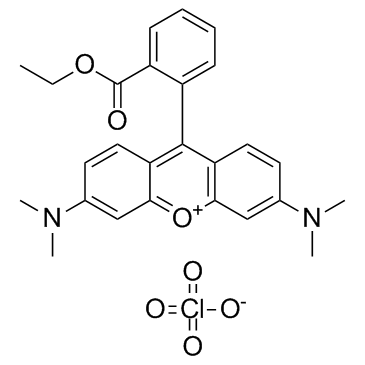TMRE

TMRE structure
|
Common Name | TMRE | ||
|---|---|---|---|---|
| CAS Number | 115532-52-0 | Molecular Weight | 514.955 | |
| Density | N/A | Boiling Point | N/A | |
| Molecular Formula | C26H27ClN2O7 | Melting Point | N/A | |
| MSDS | Chinese USA | Flash Point | N/A | |
| Symbol |

GHS07 |
Signal Word | Warning | |
Use of TMRETMRE is a mitochondria specific dye (λex=550 nm, λem=575 nm). |
| Name | [6-(dimethylamino)-9-(2-ethoxycarbonylphenyl)xanthen-3-ylidene]-dimethylazanium,perchlorate |
|---|---|
| Synonym | More Synonyms |
| Description | TMRE is a mitochondria specific dye (λex=550 nm, λem=575 nm). |
|---|---|
| Related Catalog | |
| In Vitro | TMRE is a mitochondria specific dye (λex=550 nm, λem=575 nm)[1]. Multidirectional dynamic movement of TMRE is observed in epithelial cells and bidirectional dynamic movement is seen in the superficial cortical fiber cells of live bovine lenses. In the epithelium, the movement of TMRE fluorescence is up to 5 μm/min whereas in the superficial cortex the observed movement is up to 18.5 μm/min. The movement of TMRE fluorescence is abolished with treatment of the uncoupler, carbonyl cyanide m-chlorophenylhydrazone (CCCP)[2]. |
| Cell Assay | The entire experiment should be performed at room temperature because temperature will directly impact mitochondrial transmembrane potential and TMRE staining. Cells should never be placed, centrifuged, incubated, or washed at 4°C or have ice-cold buffers or media added. Treat the cells with a cytotoxic stimulus. Harvest cells and resuspend at 5×105 cells/mL in culture medium containing 150 nM TMRE. Incubate for 5 min at room temperature in the dark. Add Carbonyl cyanide 4-(trifluoromethoxy)phenylhydrazone (FCCP) (5 μM final concentration) to an aliquot of untreated cells and incubate for 5 min at room temperature in the dark. Turn on the appropriate laser on the flow cytometer. Set up a histogram plot to detect TMRE using log scale[1]. |
| References |
| Molecular Formula | C26H27ClN2O7 |
|---|---|
| Molecular Weight | 514.955 |
| Exact Mass | 514.150696 |
| PSA | 120.19000 |
| LogP | 6.05710 |
| InChIKey | NBAOBNBFGNQAEJ-UHFFFAOYSA-M |
| SMILES | CCOC(=O)c1ccccc1-c1c2ccc(=[N+](C)C)cc-2oc2cc(N(C)C)ccc12.[O-][Cl+3]([O-])([O-])[O-] |
| Storage condition | 2-8℃ |
| Symbol |

GHS07 |
|---|---|
| Signal Word | Warning |
| Hazard Statements | H302-H315-H319-H332 |
| Precautionary Statements | P305 + P351 + P338 |
| Personal Protective Equipment | dust mask type N95 (US);Eyeshields;Gloves |
| Hazard Codes | Xn: Harmful; |
| Risk Phrases | R20/22 |
| Safety Phrases | 26-36 |
| RIDADR | NONH for all modes of transport |
|
Synergism of arsenic trioxide and MG132 in Raji cells attained by targeting BNIP3, autophagy, and mitochondria with low doses of valproic acid and vincristine.
Eur. J. Cancer 50(18) , 3243-61, (2014) We previously demonstrated that arsenic trioxide (ATO) and proteasome inhibitor MG132 synergistically induced cell death in promonocytic leukaemia cell line U937 but were antagonistic in Burkitt's lym... |
|
|
Mutations in the Corneal Endothelial Dystrophy-Associated Gene SLC4A11 Render the Cells More Vulnerable to Oxidative Insults.
Cornea 34 , 668-74, (2015) To investigate the effect of mutations in SLC4A11 on cellular localization of the protein, mitochondrial function, and apoptosis due to oxidative stress. Mutations in SLC4A11 have been associated with... |
|
|
Cyclophilin-D: a resident regulator of mitochondrial gene expression.
FASEB J. 29(7) , 2734-48, (2015) Cyclophilin-D (Cyp-D) is a mitochondrial matrix peptidyl-prolyl isomerase. Because cyclophilins can regulate nuclear gene expression, we examined whether Cyp-D could regulate mitochondrial gene expres... |
| Tetramethylrhodamine ethyl ester perchlorate |
| TMRE [Tetramethylrhodamine,ethyl ester,perchlorate] |
| 3,6-Bis(dimethylamino)-9-(2-(ethoxycarbonyl)phenyl)xanthylium perchlorate |
| MFCD00467973 |
| TMRE |
| 6-(Dimethylamino)-9-[2-(ethoxycarbonyl)phenyl]-N,N-dimethyl-3H-xanthen-3-iminium perchlorate |
| RB3096 |